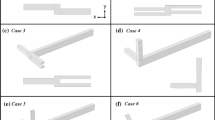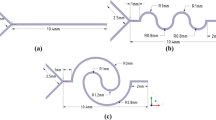Abstract
Micromixers have better efficiency in terms of both the time-scale of chemical kinetics and diffusive transport compared to the conventional macro-mixers. The mixing efficiency in micromixers is an important performance indicator in mixers. This paper presents a numerical study of how the design of a micromixer along with the design of the mixing process affects the mixing efficiency. Specifically, two different types of cross-sections of the channel in micromixers, namely circular and rectangular cross-sections, together with the inlet angle of the channel, were studied. The process parameters, such as the inlet velocity of fluids and diffusion coefficient, were studied as well. The result shows that the circular cross-section can sustain a large pressure difference without undergoing any remarkable distortion and deformation, and it can achieve better performance. The result further indicates that the inlet velocity and diffusion coefficient have significant effects on mixing efficiency; specifically, the low inlet velocity and high diffusion coefficient value can lead to a better mixing performance. However, different input angles alone could not make the mixing efficiency change noticeably. In other words, the mixing performance of such micromixers relies more on the inlet velocity and diffusion coefficient than on the fluid flow angle in the inlet.




















Similar content being viewed by others
Notes
Called mixing length.
Abbreviations
- A :
-
Cross-sectional area (m2)
- C :
-
Concentration of reagents (mol/m3)
- D :
-
Diffusion coefficient (m2/s)
- F :
-
Force (N)
- f :
-
Mole fraction (–)
- j :
-
Diffusion (mol/s m2)
- I :
-
Identity matrix (–)
- L :
-
Microchannel length (m)
- \(M_{i}\) :
-
Mixing efficiency (%)
- R :
-
Change in concentration rate (mol/s m3)
- U :
-
Velocity (m/s)
- \(\rho\) :
-
Density (kg/m3)
- \(\mu\) :
-
Viscosity (Pa s)
- \(\sigma\) :
-
Standard deviation (–)
References
Ouyang P, Tjiptoprodjo R, Zhang W, Yang G (2008) Micro-motion devices technology: the state of arts review. Int J Adv Manuf Technol 38(5–6):463–478
Yao X, Fang J, Zhang W (2018) A further study on the analytical model for the permeability in flip-chip packaging. J Electron Packag 140(1):011001
Kwang HS, Kwon Y, Choe J (2006) Microreaction technology in practice. Stud Surf Sci Catal 159:649–652
Lei L, Bergstrom D, Zhang B, Zhang H, Yin R, Song K-Y, Zhang W (2017) Micro/nanospheres generation by fluid-fluid interaction technology: a literature review. Recent Pat Nanotechnol 11(1):15–33
Nayak A (2014) Analysis of mixing for electroosmotic flow in micro/nano channels with heterogeneous surface potential. Int J Heat Mass Transf 75:135–144
Liang Y, Weihs GF, Wiley D (2014) Approximation for modelling electro-osmotic mixing in the boundary layer of membrane systems. J Membr Sci 450:18–27
Wang Y, Zhe J, Chung BTF, Dutta P (2008) A rapid magnetic particle driven micromixer. Microfluid Nanofluid 4:375–389
Alizadeh A, Zhang L, Wang M (2014) Mixing enhancement of low-Reynolds electro-osmotic flows in microchannels with temperature-patterned walls. J Colloid Interface Sci 431:50–63
Campisi M, Accoto D, Damiani F, Dario P (2009) A soft-lithographed chaotic electrokinetic micromixer for efficient chemical reactions in lab-on-chips. J Micro Nano Mech 5:69–76
Chen CK, Cho CC (2008) Electrokinetically driven flow mixing utilizing chaotic electric fields. Microfluid Nanofluid 5(6):785–793. https://doi.org/10.1007/s10404-008-0286-4
Deng B, Tian Y, Yu X, Song J, Guo F, Xiao Y, Zhang Z (2014) Laminar flow mediated continuous single-cell analysis on a novel poly (dimethylsiloxane) microfluidic chip. Anal Chim Acta 820:104–111. https://doi.org/10.1016/j.aca.2014.02.033
Wang H, Iovenitti P, Harvey E, Masood S (2003) Numerical investigation of mixing in microchannels with patterned grooves. J Micromech Microeng 13(6):801–808. https://doi.org/10.1088/0960-1317/13/6/302
Papadopoulos V, Kefala I, Kaprou G, Kokkoris G, Moschou D, Papadakis G, Gizeli E, Tserepi A (2014) A passive micromixer for enzymatic digestion of DNA. Microelectron Eng 124:42–46
Le The H, Le Thanh H, Dong T, Ta BQ, Tran Minh N, Karlsen F (2015) An effective passive micromixer with shifted trapezoidal blades using wide Reynolds number range. Chem Eng Res Des 93:1–11. https://doi.org/10.1016/j.cherd.2014.12.003
Farahinia A, Jamaati J, Niazmand H, Zhang WJ (2019) Investigation of an electro-osmotic micromixer with heterogeneous zeta-potential distribution at the wall. Eng Res Express 1(1):015024. https://doi.org/10.1088/2631-8695/ab3a15
Buchegger W, Wagner C, Lendl B, Kraft M, Vellekoop M (2011) A highly uniform lamination micromixer with wedge shaped inlet channels for time resolved infrared spectroscopy. Microfluid Nanofluid 10:889–897
Huang MZ, Yang RJ, Tai CH, Tsai CH, Fu LM (2006) Application of electrokinetic instability flow for enhanced micromixing in cross-shaped microchannel. Biomed Microdev 8:309–315
Zhang K, Guo S, Zhao L, Zhao X, Chan HL, Wang Y (2011) Realization of planar mixing by chaotic velocity in microfluidics. Microelectron Eng 88(6):959–963. https://doi.org/10.1016/j.mee.2010.12.029
Neerincx PE, Denteneer RPJ, Peelen S, Meijer HEH (2011) Compact mixing using multiple splitting, stretching, and recombining flows. Macromol Mater Eng 296:349–361
Alam A, Afzal A, Kim KY (2014) Mixing performance of a planar micromixer with circular obstructions in a curved microchannel. Chem Eng Res Des 92(3):423–434. https://doi.org/10.1016/j.cherd.2013.09.008
Bhattacharyya S, Bera S (2015) Combined electroosmosis-pressure driven flow and mixing in a microchannel with surface heterogeneity. Appl Math Model 39(15):4337–4350. https://doi.org/10.1016/j.apm.2014.12.050
Kamali R, Mansoorifar A, Dehghan Manshadi MK (2014) Effect of baffle geometry on mixing performance in the passive micromixer. Trans Mech Eng 38(M2):351–360
Farahinia A, Zhang WJ (2019) Numerical investigation into the mixing performance of micro T-mixers with different patterns of obstacles. J Braz Soc Mech Sci Eng 41(11):491–504. https://doi.org/10.1007/s40430-019-2015-1
Hardt S, Pennemann H, Schönfeld F (2006) Theoretical and experimental characterization of a low-Reynolds number split-and-recombine mixer. Microfluid Nanofluid 2(3):237–248. https://doi.org/10.1007/s10404-005-0071-6
Hessel V, Löwe H, Schönfeld F (2005) Micromixers—a review on passive and active mixing principles. Chem Eng Sci 60(8–9):2479–2501
Farahinia A, Jamaati J, Niazmand H (2019) Investigation of slip effects on electroosmotic mixing in heterogeneous microchannels based on entropy index. SN Appl Sci 1(7):728–740. https://doi.org/10.1007/s42452-019-0751-6
Nguyen N, Wu Z (2005) Micromixers—a review. J Micromech Microeng 15:R1–R16. https://doi.org/10.1088/0960-1317/15/2/R01
Yang S-M, Chen F, Yin D, Zhang H, Yin R, Zhang B, Zhang W (2018) Flow-free droplet-based platform for spiral-striated polymorphic structure of periodical crystalline agglomerates. Microfluid Nanofluid 22(10):114. https://doi.org/10.1007/s10404-018-2137-2
Jamaati J, Farahinia A, Niazmand H (2015) Investigation of mixing in electroosmotic micromixers using Nernst–Planck equations. Modares Mech Eng 15(4):203–213
Jamaati J, Farahinia A, Niazmand H (2015) Mixing investigation in combined electroosmotic/pressure-driven micromixers with heterogeneous wall charges. Modares Mech Eng 15(7):297–306
Bhagat AAS, Peterson ET, Papautsky I (2007) A passive planar micromixer with obstructions for mixing at low Reynolds numbers. J Micromech Microeng 17(5):1017
Yoshimura M, Shimoyama K, Misaka T, Obayashi S (2019) Optimization of passive grooved micromixers based on genetic algorithm and graph theory. Microfluid Nanofluid 23(3):30
Jamaati J, Farahinia A, Niazmand H (2015) Numerical investigation of electro-osmotic flow in heterogeneous microchannels. Modares Mech Eng 15(3):260–270
Farahinia A, Jamaati J, Niazmand H (2017) Study of slip effect on electro-osmotic micromixer performance based on entropy index. Amirkabir J Mech Eng 49(3):535–548. https://doi.org/10.22060/mej.2016.776
Zhendong L, Yangcheng L, Jiawei W, Guangsheng L (2012) Mixing characterization and scaling-up analysis of asymmetrical T-shaped micromixer: experiment and CFD simulation. Chem Eng J 181:597–606
Shi X, Xiang Y, Wen L-X, Chen J-F (2012) CFD analysis of flow patterns and micromixing efficiency in a Y-type microchannel reactor. Ind Eng Chem Res 51(43):13944–13952
Jamaati J, Niazmand H, Renlsizbulut M (2013) Investigation of electrokinetic mixing in 3D non-homogenous microchannels. J Comput Appl Res Mech Eng 3(1):41–52
Haghighinia A, Movahedirad S (2019) Fluid micro-mixing in a passive microchannel: comparison of 2D and 3D numerical simulations. Int J Heat Mass Transf 139:907–916. https://doi.org/10.1016/j.ijheatmasstransfer.2019.05.084
Qaderi A, Jamaati J, Bahiraei M (2019) CFD simulation of combined electroosmotic-pressure driven micro-mixing in a microchannel equipped with triangular hurdle and zeta-potential heterogeneity. Chem Eng Sci 199:463–477. https://doi.org/10.1016/j.ces.2019.01.034
Ait Mouheb N, Malsch D, Montillet A, Solliec C, Henkel T (2012) Numerical and experimental investigations of mixing in T-shaped and cross-shaped micromixers. Chem Eng Sci 68(1):278–289. https://doi.org/10.1016/j.ces.2011.09.036
Conlisk AT (2012) Essentials of micro-and nanofluidics: with applications to the biological and chemical sciences. Cambridge University Press, Cambridge
Atkins P, De Paula J (2011) Physical chemistry for the life sciences. Oxford University Press, USA
Baccar N, Kieffer R, Charcosset C (2009) Characterization of mixing in a hollow fiber membrane contactor by the iodide–iodate method: numerical simulations and experiments. Chem Eng J 148(2–3):517–524
Chen JM, Horng TL, Tan WY (2006) Analysis and measurements of mixing in pressure-driven microchannel flow. Microfluid Nanofluid 2(6):455–469. https://doi.org/10.1007/s10404-006-0092-9
Wong SH, Ward MC, Wharton CW (2004) Micro T-mixer as a rapid mixing micromixer. Sens Actuators B Chem 100(3):359–379
Jain M, Rao A, Nandakumar K (2013) Numerical study on shape optimization of groove micromixers. Microfluid Nanofluid 15(5):689–699
Yazdi AA, Sadeghi A, Saidi MH (2015) Electrokinetic mixing at high zeta potentials: ionic size effects on cross stream diffusion. J Colloid Interface Sci 442:8–14
Mondal B, Mehta SK, Patowari PK, Pati S (2019) Numerical study of mixing in wavy micromixers: comparison between raccoon and serpentine mixer. Chem Eng Process Process Intensif 136:44–61. https://doi.org/10.1016/j.cep.2018.12.011
Giere S, Iliescu T, John V, Wells D (2015) SUPG reduced order models for convection-dominated convection–diffusion–reaction equations. Comput Methods Appl Mech Eng 289:454–474. https://doi.org/10.1016/j.cma.2015.01.020
Knobloch P, Tobiska L (2009) On the stability of finite-element discretizations of convection-diffusion-reaction equations. IMA J Numer Anal 31(1):147–164. https://doi.org/10.1093/imanum/drp020
Golbabai A, Kalarestaghi N (2018) Improved localized radial basis functions with fitting factor for dominated convection-diffusion differential equations. Eng Anal Bound Elem 92:124–135. https://doi.org/10.1016/j.enganabound.2017.10.008
Sanderse B, Misra S, Dubinkina S, Henkes RAWM, Oosterlee CW (2018) Numerical simulation of roll waves in pipelines using the two-fluid model. In: Paper presented at the 11th North American conference on multiphase production technology, Banff, Canada, 2018/12/10
Matsunaga T, Lee H-J, Nishino K (2013) An approach for accurate simulation of liquid mixing in a T-shaped micromixer. Lab Chip 13(8):1515–1521
Khaydarov V, Borovinskaya E, Reschetilowski W (2018) Numerical and experimental investigations of a micromixer with chicane mixing geometry. Appl Sci 8(12):2458
Celik IB (2008) Procedure for estimation and reporting of discretization error in CFD applications. ASME J Fluids Eng 1(6):1–7
Lee CY, Lin C, Hung M, Ma R, Tsai CH, Lin CH, Fu LM (2006) Experimental and numerical investigation into mixing efficiency of micromixers with different geometric barriers. In: Materials science forum. Trans Tech Publ, pp 391–396
Lobasov AS, Minakov AV, Kuznetsov VV, Rudyak VY, Shebeleva AA (2018) Investigation of mixing efficiency and pressure drop in T-shaped micromixers. Chem Eng Process Process Intensif 134:105–114. https://doi.org/10.1016/j.cep.2018.10.012
Viktorov V, Nimafar M (2013) A novel generation of 3D SAR-based passive micromixer: efficient mixing and low pressure drop at a low Reynolds number. J Micromech Microeng 23(5):055023
Raza W, Hossain S, Kim K-Y (2018) Effective mixing in a short serpentine split-and-recombination micromixer. Sens Actuators B Chem 258:381–392. https://doi.org/10.1016/j.snb.2017.11.135
Feng X, Ren Y, Sun H, Chen X, Zhang K, Jia Y, Hou L, Xiao M, Jiang H (2019) Effect of vortex on mass transport and mixing in microcapillary channels. Chem Eng J 362:442–452
Acknowledgements
The authors gratefully acknowledge the Department of Mechanical at the University of Saskatchewan for providing the research facilities. As well, the research is made possible to the first author by the Saskatchewan Innovation & Opportunity Scholarship (2019–2020) and the Devolved Graduate Scholarships.
Funding
This research work is not supported by any funding agency.
Author information
Authors and Affiliations
Corresponding author
Ethics declarations
Conflict of interest
The authors declare that they have no conflict of interest.
Additional information
Technical Editor: Daniel Onofre de Almeida Cruz, D.Sc.
Publisher's Note
Springer Nature remains neutral with regard to jurisdictional claims in published maps and institutional affiliations.
Rights and permissions
About this article
Cite this article
Farahinia, A., Zhang, W.J. Numerical analysis of a microfluidic mixer and the effects of different cross-sections and various input angles on its mixing performance. J Braz. Soc. Mech. Sci. Eng. 42, 190 (2020). https://doi.org/10.1007/s40430-020-02275-9
Received:
Accepted:
Published:
DOI: https://doi.org/10.1007/s40430-020-02275-9




